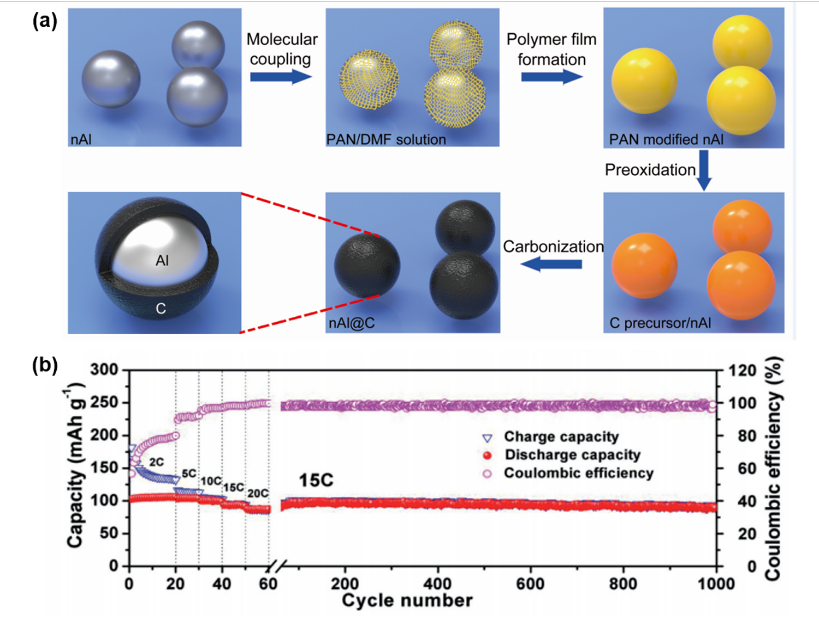nAl@C-Promising Anode Materials for High-Performance Dual-Ion Batteries
Date:07-11-2017 | 【Print】 【close】
A research team led by Prof. TANG Yongbing at Shenzhen Institutes of Advanced Technology, Chinese Academy of Sciences, collaborated with Prof. GU Lin’s team at Institute of Physics, Chinese Academy of Sciences, to develop core-shell aluminum@carbon nanospheres that could be used as promising anode materials for high performance dual-ion batteries with long cycling performance and high rate capability recently.
With the rapid development of portable electronic devices and expansion of electric cars market, there is a rising demand for dual-ion battery (DIB), a novel energy storage device with the merits of high safety, low cost and environmental friendliness. In their previous study, they developed a novel low-cost aluminum-graphite DIB (AGDIB) using Al foil as both the anode and current collector. While the AGDIB exhibits high packaged energy density of around 220 W h kg-1, the cycling stability still needs to be improved due to the crack and pulverization problem of Al foil during cycling.
To solve this issue, in this study they developed core-shell Al-carbon nanospheres (named as nAl@C) as anode materials to optimize the cycling performance of Al-based DIBs , which were composed of Al nanosphere and a protective outer layer of amorphous carbon with conductivity. It is found that the nAl@C can accommodate mechanical strain and stress better than flat electrodes, thus inhibiting pulverization. In addition, the conductive carbon layer is beneficial for conducting both Li+ ions and electrons, which would help form the SEI film. Owing to the core–shell structure, the nAl@C nanospheres demonstrate significantly enhanced electrochemical performance as anode materials for a full DIB. Especially, the nAl@C–G DIB exhibites high-rate performance as well as superior cycling stability with a capacity of 88 mA h g-1 (94.6% capacity retention) and a high Coulombic efficiency (>99.5%) after 1000 cycles at a high current rate of 15 C. In addition, the nAl@C–G DIB delivers an ultrahigh energy density of 148 W h kg-1 at a high power density of 3701 W kg-1, which is much larger than most commercial LIBs do. Furthermore, this work could also provide an effective way to synthesize other metal anodes for DIBs with high energy, power densities, and long-term cycling stability.
This research was supported by the Guangdong Innovation Team and the National Natural Science Foundation of China.

Figure. (a) A schematic of the fabrication process of the nAl@C nanospheres. (b) Long cycling performance of the nAl@C-G DIB under a high rate of 15 C.
Prof. TANG Yongbin
Shenzhen Institutes of Advanced Technology, Chinese Academy of Sciences
Shenzhen, Guangdong 518055, China
Tel: 00-86-755-86392592
E-mail: tangyb@siat.ac.cn